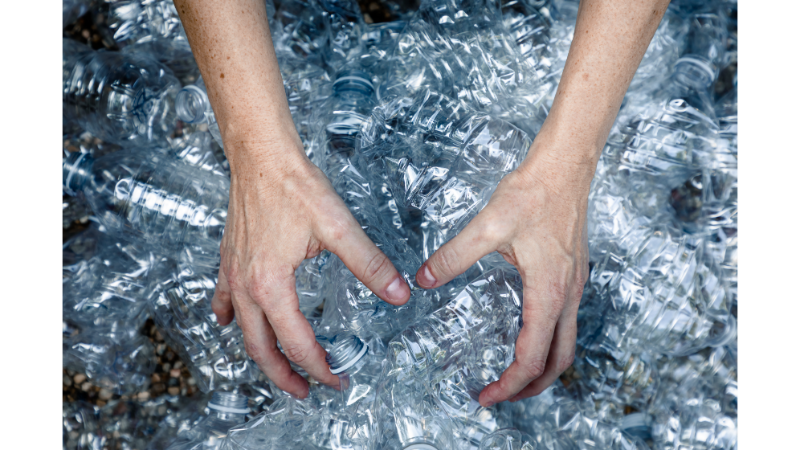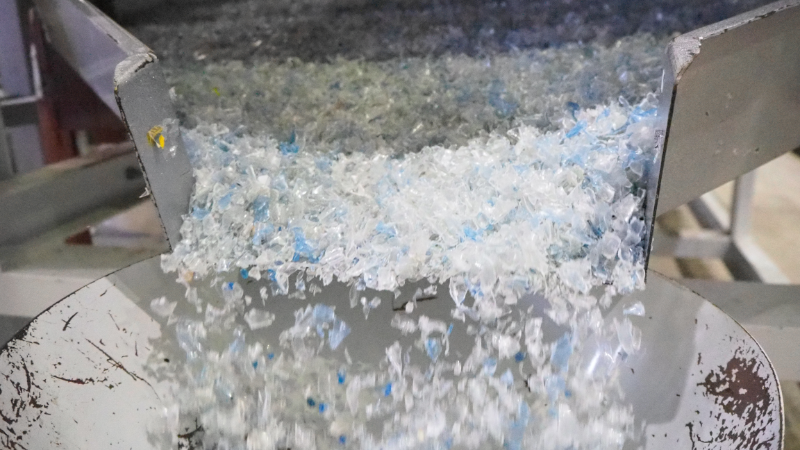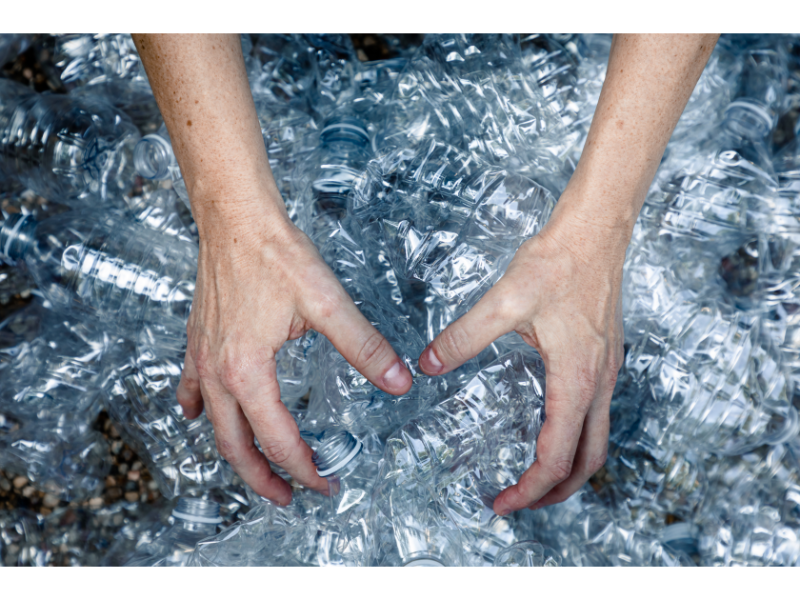Recycling activities for plastic PET bottles are among today’s most critical environmental issues. It is estimated that around 1 million plastic bottles are purchased worldwide every minute. When not properly managed, this high consumption leads to serious plastic waste problems. Although PET bottles have a short usage life, they can persist in nature for centuries. In fact, a single PET bottle can take an average of 450 years to fully decompose in the environment. For this reason, Pet bottle recycling practices are highly important for both individuals and businesses in the field of plastic waste management.
In this article, we will discuss how PET bottles are recycled. We will also examine their environmental impact and the key steps in the recycling process. Additionally, we will highlight the differences between plastic types like PET and HDPE. We will explain which materials can be recycled. Our goal is to provide a clear perspective on what can be done for a more sustainable future. It must be remembered that proper waste management helps reduce environmental burden and create economic value. In this regard, professional companies like Burkasan with 25 years of experience play a crucial role. They offer support to individuals and businesses across Turkey through integrated, sustainable systems.
Table of Contents
- How to Recycle Pet Bottles?
- Impact of Pet Bottles on the Environment
- What is the Pet Bottle Recycling Process?
- What is Pet Bottle Plastic Type (PET, HDPE difference)
- Frequently Asked Questions
- Conclusion
How to Recycle Pet Bottles?
Recycling PET bottles requires a structured process for both individuals and the recycling industry. The first step is for consumers to place used PET bottles in recycling bins or return points. So, how is a PET bottle actually recycled? The main steps can be summarized as follows:
Collection and Sorting:
Used PET bottles are first collected from recycling bins or deposit return points. Once delivered to recycling facilities, they are separated from other waste materials. At this stage, PET bottles are sorted from other plastics, glass, or metal materials. They may also be classified by color such as clear, blue, or green into separate groups.
Cleaning (Washing):
Before recycling, PET bottles must be thoroughly cleaned. Remaining liquids are emptied, and labels and caps are removed. Powerful water jets and special detergents are used to wash the PET material. This step is critical to remove dirt, glue, and organic residues. It ensures the production of high-quality recycled material.
Shredding (Grinding):
Clean PET bottles are fed into industrial shredders and broken down into small pieces. These pieces are called “flakes.” Shredding makes the plastic easier to handle and melt in the next stages.
Melting and Pelletizing:
PET flakes are melted at high temperatures in extrusion machines. The melted plastic is shaped into thin strands or filaments and immediately cooled. After cooling, the material is cut into small pellets called plastic granules.
Production of New Products:
These recycled PET granules are used as raw material for new products. For example, they can be made into new plastic bottles. They are also used in the textile industry to produce polyester fibers. This includes fleece fabrics, filling materials, and more. Recycled PET is also used in non-food packaging and automotive parts manufacturing.

Impact of Pet Bottles on the Environment
PET bottles are commonly used in daily life. However, when not recycled, they can severely harm the environment. Their impact is not limited to landfills. They remain in nature for long periods, threatening ecosystems and wildlife. They also lead to the waste of valuable energy resources. Below are the main environmental effects of non-recycled PET bottles:
1. They Remain in Nature for Centuries
PET bottles are made of plastic materials that do not easily degrade in nature. Studies show that it takes around 450 years for a single PET bottle to fully decompose. During this long period, they pollute soil, water sources, and habitats. Even if they break into smaller pieces over time, they never completely disappear. They accumulate as microplastics and disrupt ecological balance.
2. They Threaten Wildlife
Plastic waste is a serious danger to wildlife, especially in marine environments. Sea turtles, birds, fish, and marine mammals may mistake PET pieces for food and swallow them. This can cause choking, digestive issues, or even starvation. Over time, PET bottles break down into microplastics and enter the food chain. These particles may first be ingested by sea life, then by humans through seafood. This creates a significant public health risk.
3. They Waste Natural Resources and Energy
Producing PET bottles requires petroleum based raw materials and high energy consumption. This process leads to increased fossil fuel usage. If used PET bottles are not recycled, new plastics must be continuously produced from raw materials. However, recycling allows existing plastic to be reused. Compared to producing new plastic, recycling saves up to 66% energy. It also helps lower production costs and supports economic efficiency.
4. They Increase Greenhouse Gas Emissions
When PET bottles are burned or new plastics are manufactured, significant greenhouse gases are released. Carbon dioxide and methane build up in the atmosphere and contribute to global warming. Recycling requires less energy, which means fewer emissions. This makes recycling an important part of fighting climate change. It not only reduces environmental pressure but also helps lower the overall carbon footprint.
These points summarize the major environmental impacts of PET bottle waste. In conclusion, recycling PET bottles plays a critical role in protecting the environment. If not recycled, the volume of waste increases daily and becomes a growing problem for future generations. Both individuals and industries must take responsibility to minimize this impact.
What is the Pet Bottle Recycling Process?
Pet bottle recycling is a systematic process that transforms waste into reusable raw materials. This process contributes to the conservation of natural resources and reduces environmental impact. Here are the basic steps of this process:

1. Collection and Transportation
Recycling begins with the separate collection of PET bottles from other types of waste. Bottles are gathered from homes, workplaces, and public spaces. They are stored in recycling bins or containers.
These collected bottles are then baled and transported to recycling facilities.
2. Sorting
At the facility, waste is sorted using conveyor belt systems. PET bottles are separated based on type (PET, HDPE, etc.) and color (clear, colored). Caps, rings, and labels are also removed during this stage.
Proper sorting is critical for producing high quality recycled raw materials.
3. Shredding and Washing
Separated PET bottles are shredded into small pieces called “flakes.” These flakes are washed using hot water and cleaning chemicals. Dirt, label residues, and different types of plastics are separated.
In some facilities, flotation tanks are used to separate lighter plastics like caps.
4. Drying and Melting
The washed PET flakes are dried to remove moisture. Then, they are melted at high temperatures using extrusion machines. This prepares the material for the next step: granule production.
5. Pelletizing
The cooled plastic strands are cut into small, uniform plastic pellets. These pellets are used as recycled plastic raw materials in various industrial applications.
6. Production of New Products
The resulting pellets are reused in industries like textiles, packaging, and automotive. For example, they are used to produce polyester fiber or plastic bottles and packaging. Some brands now include recycled PET in their beverage packaging as well.
What is Pet Bottle Plastic Type (PET, HDPE difference)
“PET,” or Polyethylene Terephthalate, is a lightweight, transparent plastic suitable for food contact. It is widely used, especially in water and soft drink bottles. In recycling codes, it is marked with the number 1. PET is usually produced for single use and is not recommended for repeated refilling. Reusing it can pose health risks.
PET is a valuable raw material in recycling. When collected and processed correctly, it becomes recycled PET (rPET). rPET can be reused in bottle production or other sectors such as textiles. This helps conserve resources and reduce environmental impact.
Besides PET, another common plastic in daily life is HDPE. HDPE stands for High-Density Polyethylene and is identified with recycling code number 2. It is used in milk bottles, cleaning product containers, toys, and plastic pipes. This material is more rigid and opaque than PET. It also has higher chemical and heat resistance. Due to its thick and durable structure, HDPE can often be reused several times.
Both PET and HDPE are recyclable plastics, but their properties and applications differ. PET is mostly used in transparent beverage packaging. HDPE is preferred for opaque and more durable containers. In recycling facilities, these two plastics are processed on separate lines. This is because their melting points and physical structures are different.
As consumers, we can identify the plastic type by checking the triangle symbol on packaging. Products marked with “1 PET” should always go into recycling bins. Likewise, “2 HDPE” labeled packaging is recyclable and valuable. Recognizing this distinction is vital for proper waste management and environmental sustainability.

As a result, proper sorting and processing of recyclable plastics, whether PET or HDPE, makes a significant contribution to conserving natural resources and reducing the impact of waste on the environment.
Frequently Asked Questions
How Long Does PET Bottle Recycling Take?
The term “PET bottle recycling time” is often confused with its environmental decomposition time. A PET bottle discarded in nature can take around 450 years to fully break down. However, the recycling process is much shorter. When properly sorted, PET bottles can be reprocessed in a few weeks to a few months.
They are then turned into new plastic products and reintroduced into the economy in a short time.
What Should Be Done Before Disposing PET Bottles in Recycling Bins?
To ease the recycling process and maintain hygiene, some basic steps should be followed. First, ensure the bottle is completely empty. If sugary or dirty residues remain, rinse the bottle briefly with water.
Next, remove the cap. Caps are often made from a different type of plastic and are more efficiently recycled separately. Finally, press the bottle vertically to reduce its volume.
Which Plastics Can Be Recycled?
A plastic item’s recyclability is shown by the number inside its triangle symbol. The most commonly recycled plastics are coded 1 (PET), 2 (HDPE), 4 (LDPE), and 5 (PP). These include water bottles, milk and detergent containers, plastic bags, and yogurt cups. Plastics labeled 3 (PVC), 6 (Polystyrene), and 7 (Other) are harder to recycle. They are not always accepted in standard recycling systems.
What Is Plastic Waste Management and Why Is It Important?
Plastic waste management refers to collecting, sorting, recycling, or safely disposing of plastics. This process begins after plastics reach the end of their usable life. It is essential for protecting the environment from soil, water, and air pollution. Choosing recycling over plastic production also leads to significant energy savings.
Conclusion
PET bottle recycling is critically important for both environmental protection and economic sustainability.
In the face of rising plastic consumption, recycling and circular economy practices are no longer optional.
They are now a necessity. This process helps preserve natural resources. It reduces energy consumption and prevents environmental pollution. Especially through recycling, significant savings in energy and raw materials can be achieved compared to new plastic production.
Individuals can contribute to this process with simple steps in daily life. For example, collecting PET bottles separately and placing them in recycling bins is a great start. Companies, on the other hand, should use recyclable materials in production. They should also implement proper waste management plans.
Of course, this transformation requires strong infrastructure and expertise. At this point, Burkasan provides comprehensive waste management solutions with over 25 years of experience in Turkey. With integrated systems and a wide service network, Burkasan helps minimize environmental impact. It supports both individuals and institutions. It also facilitates progress toward zero waste and sustainability goals.
In conclusion, every PET bottle thrown into nature continues to harm the environment for decades.
PET bottle recycling is not the end. It is a sustainability journey that restarts with every bottle.
If you would like to explore more content on behalf of Burkasan, feel free to read our other articles.

